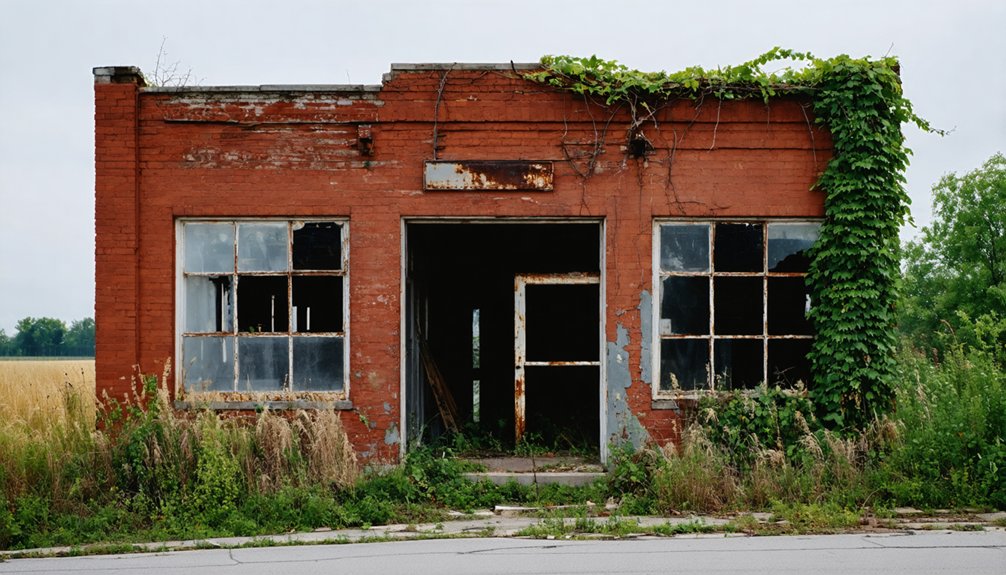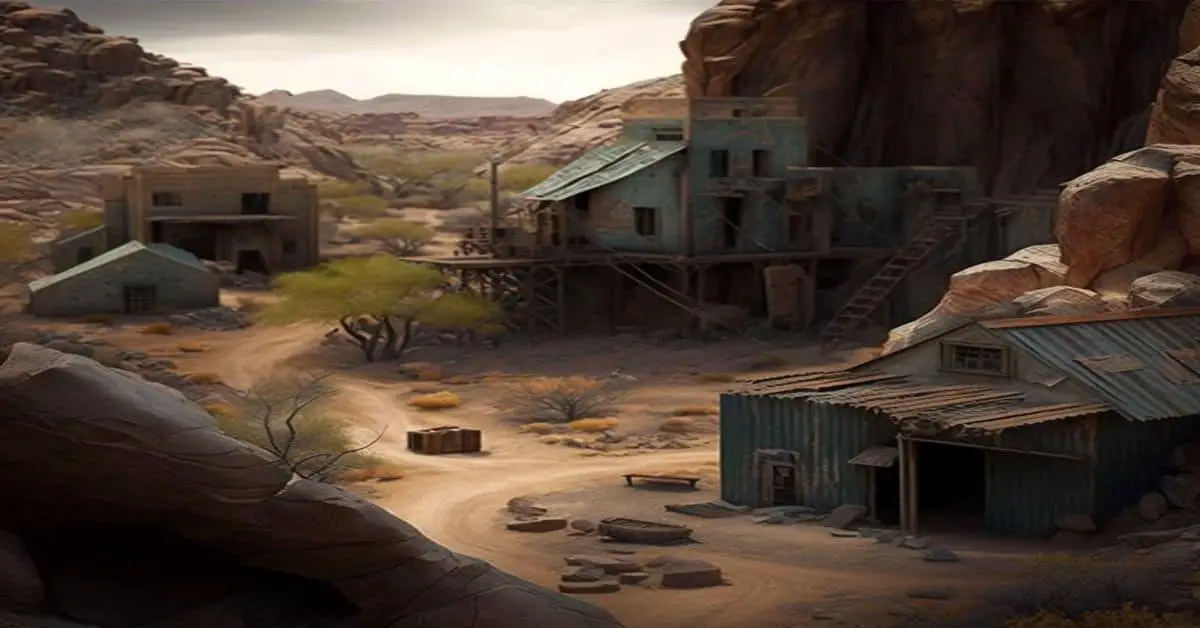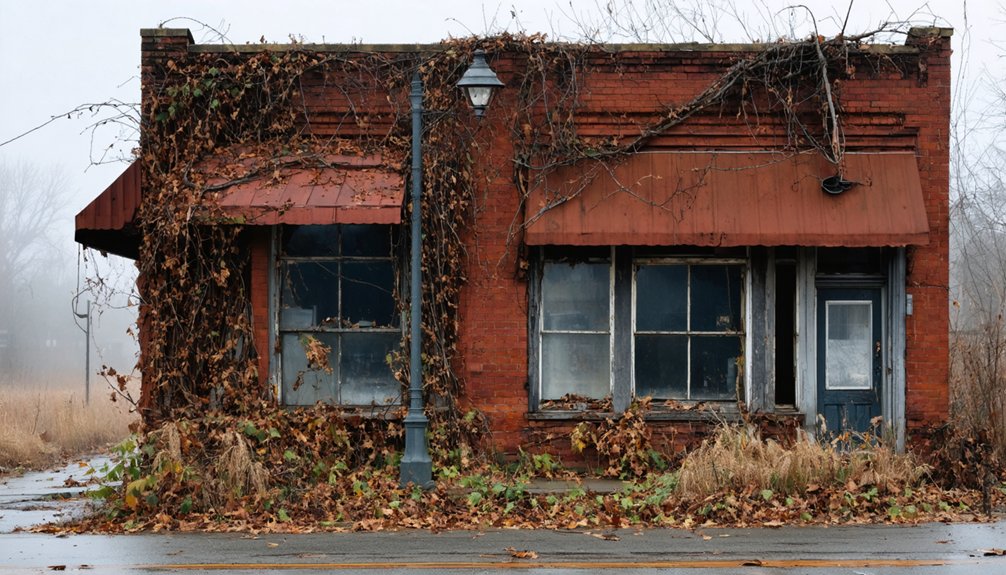You’ll find Mollie at the intersection of Blackford County roads 400 North and 300 East in Indiana, where a thriving oil boom town once stood. Founded in the 1880s, it quickly became a bustling commercial center with banks, stores, and an essential railroad station. By 1907, declining oil production led to its abandonment, and today only two original houses remain. The town’s story captures the rise and fall of Indiana’s industrial heritage, with layers of history waiting to be uncovered.
Key Takeaways
- Mollie was a bustling Indiana oil boom town in the late 1800s, situated at the intersection of Blackford County roads 400 North and 300 East.
- The town flourished as a railroad transportation hub until 1941, supporting oil production and local commerce during Indiana’s industrial expansion.
- Economic decline began around 1900 when oil production decreased, leading to business closures and population loss.
- The post office’s closure in 1907 marked a significant turning point in Mollie’s decline toward ghost town status.
- Today, only two original houses remain, with most of the former townsite converted to farmland along an active Norfolk Southern railway.
The Birth of an Oil Boom Settlement
When Indiana’s natural gas boom ignited in 1876, it transformed the landscape of towns like Mollie from quiet farmland into bustling industrial settlements. You’d have witnessed the dramatic changes as the Trenton Gas Field, spanning over 5,120 square miles, sparked unprecedented growth across the region. By 1903, coal-burning electric plants became necessary as gas resources depleted.
The combination of oil discovery and gas extraction drew industries seeking cheap fuel, particularly after George W. Carter’s successful well drilling in nearby Eaton at 922 feet in 1886. The region’s rich farmland from past glacial activity made it an ideal location for both agriculture and industrial development. The region’s swamplands were quickly drained, and railways built in the 1860s and 1870s provided essential transportation infrastructure.
You’ll find it fascinating that the “Wainwright Wonder” well near Noblesville became one of central Indiana’s most productive sites, exemplifying the resource-rich environment that made Mollie’s industrial development possible.
A Bustling Business Center Emerges
The natural gas and oil boom transformed Mollie into a dynamic business center by the 1890s.
By the late nineteenth century, Mollie’s oil and gas discoveries catapulted the town into a thriving commercial powerhouse.
You’d have found multiple banks providing essential financial services, while the post office served as a hub for community engagement and commercial correspondence. The town’s train station connected merchants to broader markets, facilitating the movement of oil, supplies, and passengers throughout the region. Like modern development initiatives, the town attracted businesses through improved infrastructure and services.
Local businesses thrived, with general stores stocking necessities for residents and workers alike. The discovery of oil in Blackford County 1876 sparked the town’s initial development and rapid growth.
Cider mills and various industrial operations contributed to the town’s economic diversity. As Mollie’s prominence grew, it became a vital node in the local supply chain, drawing workers and families to settle in the area.
The concentration of commerce, coupled with the Trenton Oil Field’s success, established Mollie as a significant regional business hub.
Peak Years of Growth and Prosperity
During Mollie’s peak years in the late 1880s through early 1900s, you’d have witnessed an economic transformation driven by the discovery of oil in 1876 and subsequent development of the Trenton Oil Field.
The town’s strategic railroad location made it an essential transportation hub, facilitating the movement of oil, goods, and passengers throughout the region. Similar to abandoned town Liberty, the community dealt with ongoing health challenges from industrial development. Much like other Indiana settlements during the post-Civil War period, the town experienced rapid industrialization and growth.
You’d have found a thriving commercial district filled with general stores, banks, and various businesses that emerged to serve the rapidly growing population of oil workers and their families.
Oil Boom Economic Impact
Following Mollie’s remarkable oil discovery in 1876, this small Indiana town transformed into a thriving economic hub within the vast Trenton Oil Field region.
You’d have witnessed unprecedented growth as oil revenue poured into local banks, spurring rapid infrastructure development and job creation across multiple sectors.
The boom brought you essential services: a post office, general stores, and cider mills emerged to support the expanding population.
With an estimated 1 billion barrels of oil and 1 trillion cubic feet of natural gas reserves, Mollie’s economic prospects soared.
The strategic placement of a train station amplified market access, while banking institutions financed new drilling operations. Like California Star Oil Company, many local oil enterprises grew into major petroleum corporations.
Local farmers benefited too, as their agricultural ventures gained stronger markets and supplemental income from oil-related activities.
Over 200 companies rushed to establish 380 wells within three years, demonstrating the region’s explosive industrial growth.
Railroad Transportation Hub
As rail lines expanded across Indiana in the late 19th century, Mollie emerged as an essential transportation hub along County Road 400 North in Blackford County.
This pivotal chapter in railroad history positioned the town as a vital nexus for both passenger and freight traffic until 1941.
You’ll find that Mollie’s peak growth in the 1880s-1890s directly correlated with the transportation evolution sweeping through Indiana.
Like the National Recreation Trail designation that would later recognize other historic rail corridors, Mollie’s railroad station played a crucial role in regional development.
The railroad station bustled with daily passenger service while facilitating the export of oil, agricultural products, and manufactured goods to regional markets.
Similar to Tunnelton’s experience with its brick-lined tunnels in 1898, the rail system required significant infrastructure improvements to ensure safe operations.
The rail system didn’t just move products – it brought prosperity, connecting Mollie’s residents and businesses to broader commercial networks.
When passenger service ended in 1941, it marked the beginning of the town’s decline, demonstrating how deeply the railroad had shaped Mollie’s destiny.
Commercial District Expansion
The discovery of oil in 1876 transformed Mollie into a bustling commercial hub, where prospectors and entrepreneurs flocked to establish a diverse array of businesses.
You’d find thriving general stores, banks, and cider mills dotting the landscape, all supporting the town’s rapid economic diversification beyond just oil production.
The Turning Point and Economic Decline

Once oil production began declining around 1900, Mollie’s economic fate quickly unraveled. The town’s economic resilience, previously buoyed by the robust oil industry, couldn’t withstand the rapid downturn in extraction activities.
You’d have witnessed dramatic shifts in community dynamics as businesses shuttered and residents sought opportunities elsewhere.
The closure of the post office in 1907 marked a significant milestone in Mollie’s decline, signaling the erosion of vital services.
When the passenger train service ended in 1941, you’d have seen the final blow to the town’s viability. Without this essential transportation link, remaining residents faced isolation and limited economic prospects.
Agricultural fields gradually reclaimed the land where thriving businesses once stood, transforming the former boomtown into another Indiana ghost town.
What Remains: Present-Day Traces
Today’s visitor to Mollie encounters sparse evidence of its former liveliness, with just two original houses standing at the intersection of Blackford County roads 400 North and 300 East.
You’ll find the site has largely returned to private farmland, with agricultural fields replacing what was once a bustling community.
While the Norfolk Southern railway line still runs through the area, the interurban tracks that helped sustain Mollie’s economy have long since vanished.
Physical remnants are scarce – no trace remains of Jacob Burnworth’s grocery store or tile factory.
The surrounding landscape reveals little of its past, and community memory lives on primarily through historical narratives rather than tangible structures.
Without preservation efforts or historical markers, Mollie’s physical legacy has largely faded into the Indiana countryside.
Legacy in Indiana’s Industrial Heritage

Emerging from Indiana’s late 19th-century oil boom, Mollie stands as a compelling example of the state’s industrial heritage and resource-driven development.
You’ll find in its story a reflection of both industrial resilience and vulnerability, as the town’s rise and fall mirror broader economic cycles that shaped the Midwest’s post-Civil War landscape.
When you examine Mollie’s trajectory, you’ll recognize how resource depletion transformed countless similar communities across Indiana.
The town’s brief but significant role in the state’s oil industry offers essential insights into how natural resources sparked settlement patterns and shaped transportation networks.
Today, Mollie’s legacy lives on primarily through historical documentation, helping you understand the complex relationship between industrial ambition and sustainable community development in Indiana’s past.
Frequently Asked Questions
Were There Any Notable Crimes or Lawlessness During Mollie’s Boom Years?
You won’t find evidence of high crime rates or major lawlessness – historical records don’t mention notable criminal activity, and the town lacked formal law enforcement during its oil boom years.
What Was the Maximum Population of Mollie at Its Peak?
While exact records don’t exist, you’d find Mollie’s peak population reached around 200-300 residents during the 1890s oil boom, reflecting typical population growth patterns of Indiana’s historical gas and oil boomtowns.
Did Any Famous Personalities or Historical Figures Visit Mollie?
You won’t find records of famous visitors to Mollie, as its historical significance centered purely on oil production. No documented evidence exists of any nationally or internationally known figures visiting the boomtown.
What Were the Average Oil Worker Wages in Mollie?
You’ll find oil workers in Mollie earned approximately $10-13 weekly during the late 1800s, aligning with regional industry standards. The oil industry’s economic impact considerably shaped local wage patterns.
Were There Any Schools or Churches Established in Mollie?
Like footprints in shifting sand, you won’t find evidence of schools or churches in Mollie’s records. Historical documents don’t mention any education infrastructure or religious institutions established there.
References
- https://raregoldnuggets.com/?p=3933
- https://www.youtube.com/watch?v=45D4dbASJyE
- http://freepages.rootsweb.com/~gtusa/history/usa/in.htm
- http://ingenweb.org/inlawrence/abandoned.htm
- https://www.atlasobscura.com/users/lendog666/lists/ghost-towns
- https://www.onlyinyourstate.com/experiences/indiana/ghost-towns-in
- https://en.wikipedia.org/wiki/List_of_ghost_towns_in_Indiana
- https://www.wmsmith-family-history.com/copy-2-of-template
- https://en.wikipedia.org/wiki/Blackford_County
- https://hoosierhistorylive.org/mail/2014-06-07.html



